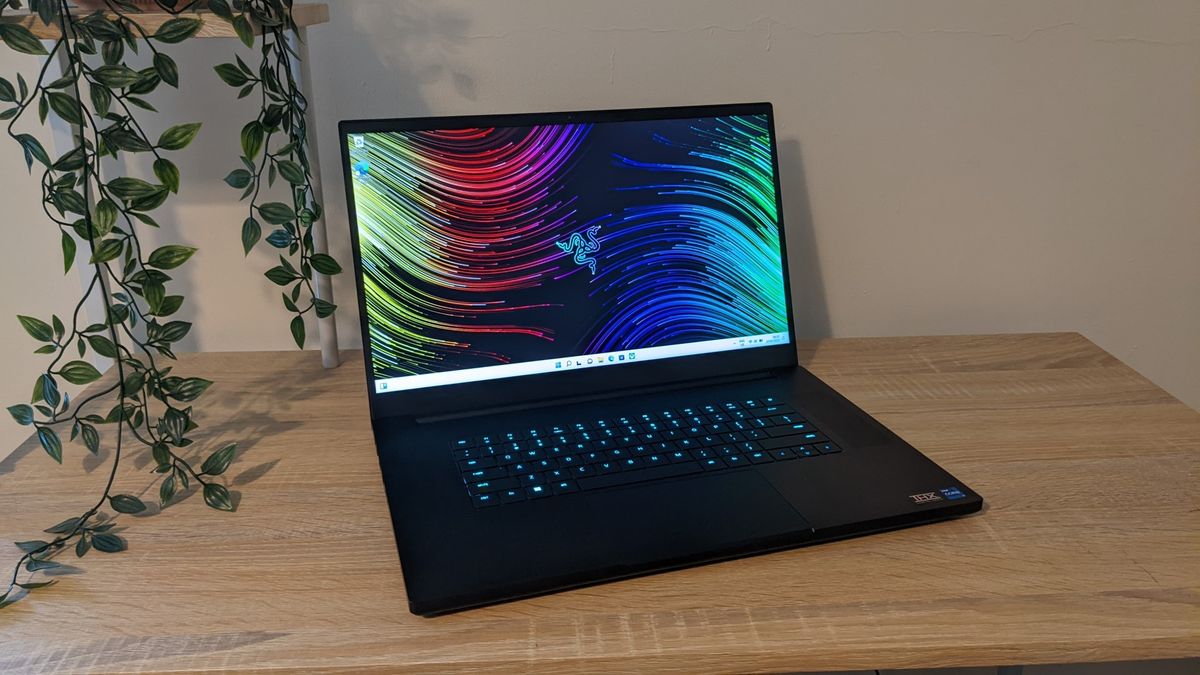12DOVE Verdict
A powerhouse of a gaming laptop that is equally adept at content creation, but comes with a pretty brutal price tag.
Pros
- +
Top-notch gaming performance
- +
Gorgeous 17-inch display
- +
Good for content creation
- +
Signature chassis is still stylish and robust
Cons
- -
Stupidly expensive
- -
Dismal battery life
- -
Too heavy to easily carry about
Why you can trust 12DOVE
Razer laptops have something for everyone. From the super-portable Blade 14 to the heavyweight powerhouse Razer Blade 17, they’re practically guaranteed to make you the envy of your friends. This latest iteration of the latter is no exception, providing incredible performance in a sleek design - provided you can afford it, since this high-end model costs a whopping $4,000.
Yes, Razer gear is known for its eye-watering price tags, the Blade series most of all. But if you’ve got money to burn and want a desktop-replacement gaming laptop for some high-end gaming or content creation (or both!), the Razer Blade 17 is an excellent choice that we wholeheartedly recommend.
Design
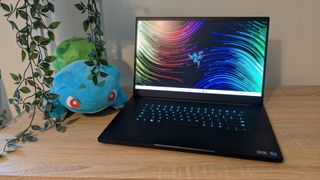
If you’ve ever handled a Razer laptop before, you’ll know roughly what to expect here. A slender chassis of anodized aluminum, painted jet black, with the softly glowing Razer logo resting atop it - so far, so two years ago. The black metal is still a fingerprint magnet, so keep a cloth handy.
Opening up the lid doesn’t reveal anything else new; we’ve got the same RGB-backlit keyboard flanked by subtle stereo speaker grilles, a precision glass trackpad, and a pleasingly tiny bezel around the 17-inch display. A 1080p webcam with IR for Windows Hello nestles above the screen.
It feels a little strange that there’s no numpad here, though previous models of the Blade 17 shared this missing feature. Most 17-inch laptops (and many 15-inch ones) manage to cram in a numpad or implement a dual-function transforming trackpad like the Asus Vivobook Go, but here there’s a lot of empty space around the keyboard. Perhaps it’s to make more room for the speakers, but some users will certainly feel its absence.
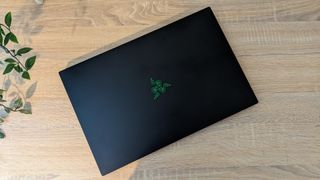
Theses all-metal chassis can historically get a bit toasty when you’re playing games or running resource-intensive software, so heat is vented from a long grille between the keyboard and the screen hinge, with cool air sucked in by powerful fans on the underside of the laptop. This means that you won’t get hot air blowing on your hand if you’re using a mouse.
In terms of physical ports, we’ve got a great selection here; three USB-A ports are joined by two Thunderbolt 4-enabled USB-C ports, an SD card reader, Ethernet port, and an HDMI output for connecting a second display.
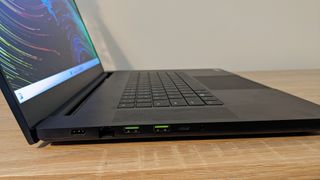
The right-angled charger can block the Ethernet and one of the USB-A ports unless it’s plugged in facing the rear of the laptop, but this is only a minor annoyance. The AC adaptor isn’t too big, but the laptop itself is obviously a bit of a beast. At almost three kilograms and forty centimetres wide, it’s not exactly a backpack-friendly laptop.
Features
Processor: Intel Core i7-12800H
Graphics: Nvidia GeForce RTX 3080 Ti
Memory: 32GB DDR5 RAM @ 4,800MHz
Display: 17.3-inch, 16:9, 240Hz
Resolution: 2560 x 1440
Storage: 1TB Gen4 M.2 PCIe NVMe SSD
Ports: 1x 3.5mm Combo Audio Jack, 1x HDMI, 2x USB 3.2 Gen 2 Type-A, 2x Thunderbolt 4, 1x RJ-45 Ethernet, SD card reader
Connectivity: Wi-Fi 6E, Bluetooth 5.2
OS: Windows 11 Home 64-bit
Weight: 2.75kg
In terms of internal components, the Razer Blade 17 is, unsurprisingly, a performance-oriented monster of a laptop. An RTX 3080 Ti GPU is joined by a 14-core 12th-gen Intel i7 processor and 32GB of next-gen DDR5 RAM, meaning that this sits among the most powerful gaming laptops you can buy right now.
This model we were sent for review has a 1440p 240Hz display, and costs a wallet-battering $3,999.99. There are a few different versions available, with the cheapest swapping out the GPU and memory for an RTX 3060 and 16GB of DDR5, costing a still-pricey $2,799.99.
Still, that big display is absolutely gorgeous. Amazing clarity and sharpness is joined by 99% sRGB color reproduction that artists and photo editors will love, with vibrant hues and crisp, deep blacks. Combined with the top-tier components, this means that the Blade 17 can very happily double up as a platform for content creation work as well as high-end gaming.
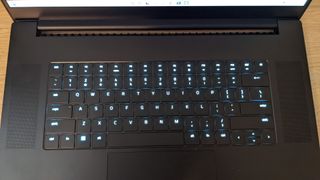
It’s not just visuals that are impressive, but audio too. An eight-speaker array provides amazing audio with clear highs and booming bass, so this is one of the few gaming laptops out there that doesn’t immediately come with a recommendation to buy a gaming headset.
Using the RGB keyboard and trackpad is a pleasure; there isn’t quite as much travel on these keys as some gaming laptops, but it’s certainly comfortable enough for extended use and feels sufficiently responsive for gaming. The trackpad is sensitive and has a nice firm click to it, and palm rejection is good, so you won’t have to worry about accidentally activating the trackpad while gaming with a mouse.
Of course, since this is a Razer laptop running Windows 11, it comes preloaded with some mildly annoying bloatware from Razer as well as Microsoft and Nvidia. Some of this is easily removed, but you’ll need to keep most of the Razer software if you want to tweak your RGB lighting effects. Razer Synapse has at least been refined over the years, and is much less annoying to use than it once was.
Performance
Fire Strike: 25,484
Fire Strike Extreme: 15,094
Time Spy: 12,244
PC Mark 10 (Modern Office test): 4,150
Cinebench (Multi): 5,139
Crystal Disk Mark: 6,939 MB/s read; 4,791 MB/s write
Shocking exactly nobody, the 2022 Razer Blade 17 eats benchmarks for breakfast and powers through the latest games at 1440p, even without the assistance of Nvidia’s nifty DLSS tech. The RTX 3080 Ti is a beast, and the new efficiency/performance core design of the 12th-generation Intel processors is clearly put to good use here.
The Blade 17 annihilated our selection of gaming benchmarks at 1440p, staying comfortably above 60fps at maximum graphical settings in every game we tested. Ray-tracing is very much on the table, with the punishing Metro Exodus RTX benchmark still returning a 60+fps result at 1440 - with DLSS on, this framerate could be pushed even higher. Synthetic graphics benchmarks were a breeze too, with high scores in 3DMark’s Fire Strike and Time Spy tests.
CPU performance was excellent but not the very best you can get in a gaming laptop - an even more expensive Razer Blade 17 packing an Intel Core i9 processor is also available, which will offer superior multi-core performance, but unless you’re specifically hankering for a super-charged CPU it’s not a must-have inclusion.
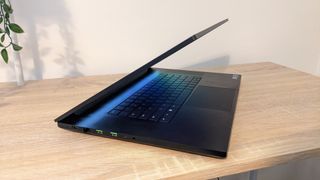
SSD read and write speeds were top-notch, as we’d expect from a high-end laptop like the Blade 17. With a read speed approaching 7GBps on the Gen4 M.2 drive, load times in games will be speedy and transferring files should take no time at all.
All that power comes at a price, though. The Razer Blade 17 has some undeniably noisy fans on it, with a certain low-pitched whine discernable even when the system is idling on the Windows desktop. That metal chassis also gets pretty darn hot, with the space above the keyboard rapidly becoming too warm to touch when running demanding games. Internal component temperatures remained within a safe range, though, so thermal performance bottlenecks shouldn’t be a concern here.
Lastly, the battery sits somewhere between ‘unimpressive’ and ‘shockingly abysmal’, lasting just one hour in the PCMark 10 gaming battery life test. Granted, gaming laptops aren’t known for their great battery life, but this is a particularly poor showing. Simple tasks like web browsing and word processing obviously won’t drain the battery as fast, but all-day use is off the table.
| Header Cell - Column 0 | 1440p High | 1440p Ultra |
|---|---|---|
| Total War: Three Kingdoms | 98fps | 69fps |
| The Division 2 | 101fps | 73fps |
| Metro Exodus | 90fps | 75fps |
| Shadow of the Tomb Raider | 146fps | 134fps |
| Red Dead Redemption 2 | 104fps | 90fps |
Should you buy the Razer Blade 17?
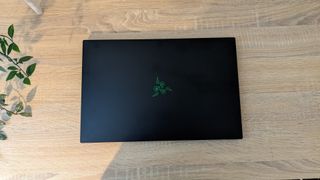
The Razer Blade 17 frankly isn’t a laptop that the average gamer needs (though it might be the one they want). That being said, if you can afford it and you really want a 17-inch laptop, this is one of the best options available right now, and the durable chassis means it should last you for years.
Top-tier gaming and multimedia performance is what we’d expect from a laptop this expensive, and the Blade 17 delivers in spades. The incredibly vibrant display is another huge bonus, even if the battery life means that this gaming laptop is better suited as a desktop replacement than an on-the-go system.
If you're after that Razer feel without such a hefty price tag, the Razer Blade 15 is our go-to this year. It's still an expensive piece of kit, yes, but if you don't need that 17-inch display it's worth noting that the smaller model packs a serious punch.
How we tested the Razer Blade 17
We used this beefy laptop as a desktop replacement PC for almost a full week, getting to grips with its big, beautiful display and comfortable keyboard as we used it both for day-to-day work and the odd bit of cheeky lunch-break gaming. We took it out and about once, to a cozy coffee shop, where it took up too much space on our little corner table and barely fit inside a regular laptop bag.
Our benchmarking process is much the same as you’ll find in our other gaming laptop reviews, with five games tested at Ultra and High presets (along with the punishing Metro Exodus RTX test). We also ran a selection of synthetic benchmarks to gauge general performance in other areas.
You can read more about our hardware approach, and how we test gaming laptops, in our full 12DOVE Hardware Policy.
For something a little more permanent, check out our guide to the best gaming PC available right now. Or, to update your setup fully, take a look at the best gaming mouse and best gaming keyboard models on the market.
Christian is a writer for Maximum PC, but also writes in a freelance capacity for a number of other sites including GamesRadar, PC Gamer, and TechRadar. He knows the PC gaming space inside out, particularly when it comes to hardware including PC builds, keyboards, and other peripherals.

Ahead of GTA 6, Take-Two CEO says he’s “not worried about AI creating hits” because it’s built on recycled data: “Big hits […] need to be created out of thin air”
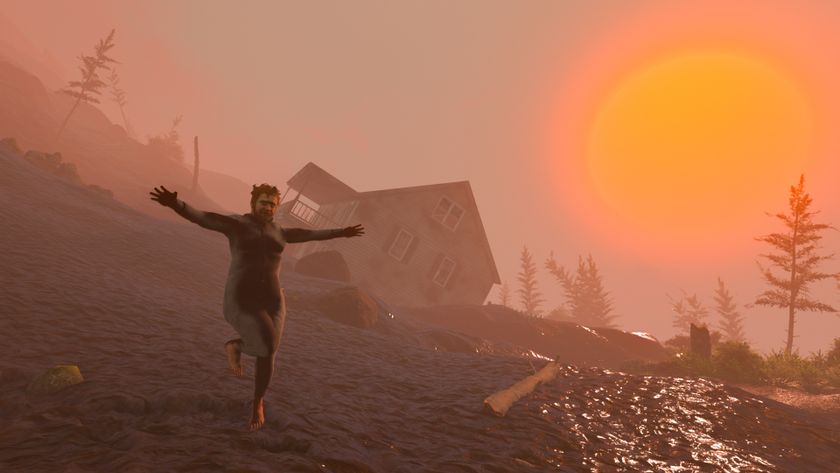
Getting Over It creator Bennett Foddy threatens the world once again: If you want Baby Steps to be a brutal rage game, "you can inflict that on yourself"

A Simpsons Hit and Run Remake will probably never happen – and I don't want it to
